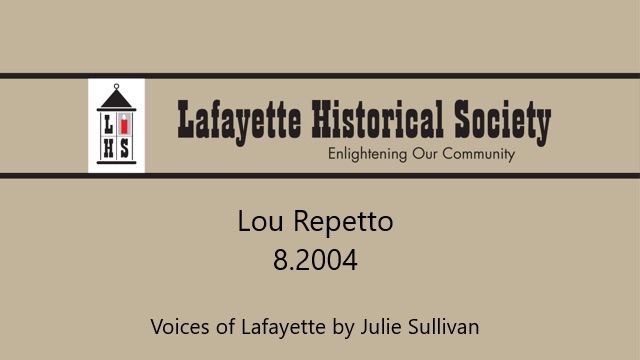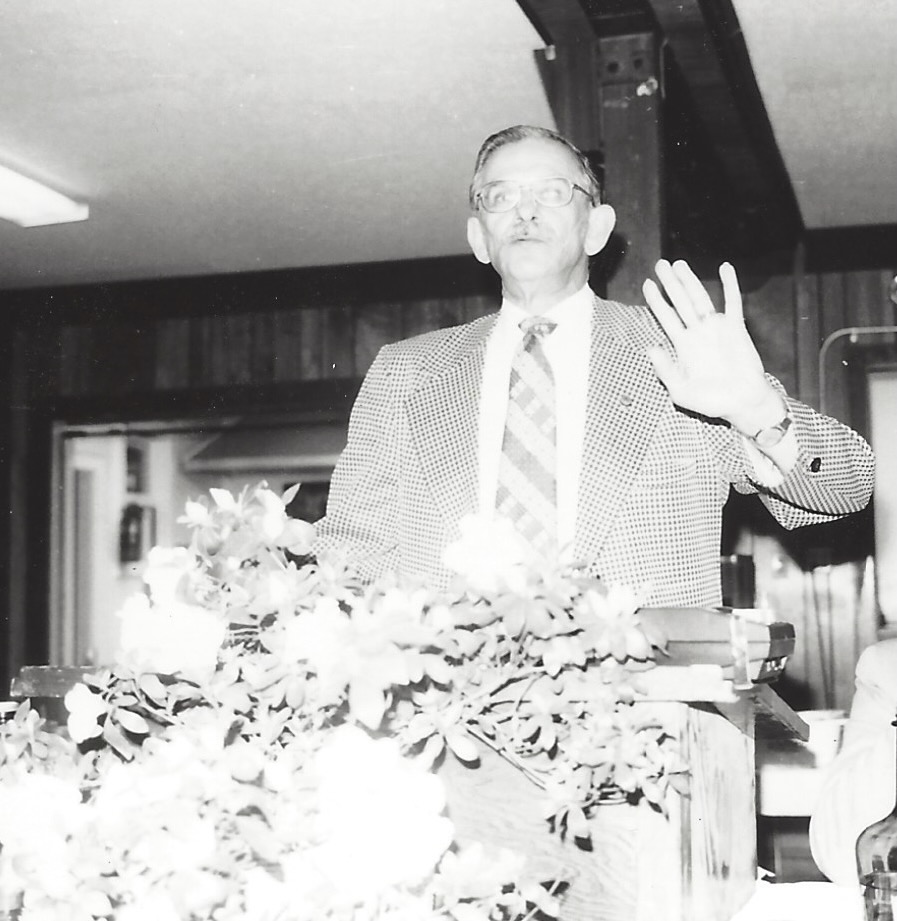Summary:
Lou Repetto was interviewed by Julie Sullivan in August, 2004. A San Francisco native, he decided to settle in this area after serving in World War I and he co-founded the Lafayette Garbage Disposal Service company. Lou discovered that becoming active in the local Lions Club was a good way to build his business network. Along with a partner, Art DiGracia, he eventually expanded into repairing autos and trucks and developing commercial buildings. Later on he became Chairman of the Lafayette Design Project, an organization that is credited with creating the basic layout of the City that has been maintained up to the present day.
Oral History:
“It was the best move I ever made,” Lou Repetto describes his decision to move to Lafayette and become a garbage man in spite of his father’s disapproval. It was 1946, and Lou was just back from serving in the Pacific when he and his future wife’s brother, Art DiGracia, put up $12,000 each for half of what was then the Lafayette territory.
Lou, who was born in San Francisco, was attending San Francisco State College when World War II broke out. He was drafted and served three years, returning to Cow Hollow where his parents ran a grocery store. “I went back to San Francisco State, thinking I could resume my education, but I was an old man among all those young students, and I decided it wasn’t for me.”
Norma DiGracia got Lou a job as a bookkeeper at a wholesale fish factory. Her brother, Art, wanted Lou to go into business with him. “Art’s landlord was a retired garbage man, and he told Art, it doesn’t sound like a good title, but the richest men in San Francisco are garbage men.”
Art’s cousin, Adolph Panfilli, had a fish market in Lafayette. When Art and Lou came to Lafayette on Memorial Day, 1946, to pick walnuts, Adolph told them one of the partners in the Lafayette garbage company wanted to retire. They could buy half the territory if they each came up with $12,000. “I asked my dad to help me, but he refused because he didn’t want me to be a garbage man,” Lou says. “My future in-laws loaned me the money.
“Art and I had two beat-up old trucks and one employee. We named our company the Lafayette Garbage Disposal Service. Art was the equipment man, and I became the PR person. There were no known landmarks in the area except Charles Hill Road, which is sort of the boundary between Orinda and Lafayette. Our share was everything to Charles Hill east to about where the Lafayette Park Hotel is now, with the exception of an area south of the city that was nothing but an orchard and tracks for the old Sacramento Northern Railway.”
Unknowingly, they shut themselves off from a big territory. That southern area was to become Burton Valley. “At that time Lafayette was just exploding,” Lou remembers. “Houses were like mushrooms popping out of the ground.
“In those days it was hair-raising to drive down Mt. Diablo Boulevard. It had three lanes, one going east, one going west, and the middle lane was ‘suicide alley’ because more people were killed trying to pass another car by going into the middle lane. There were a lot of head-on collisions.”
When he bought half the company, Lou didn’t know how to drive a car. His in-laws loaned him a car to take his driver’s test. “The garbage trucks then weren’t automatic,” he says. “We had to dump the cans in by hand, and when the load got kind of full, we had to jump in and pack it down with our feet.”
Their routes started around 4:00 a.m., because the traffic on Mt. Diablo Boulevard before the freeway was built made the street difficult to cross later in the day.
In 1947 Lou and Norma were married, and in 1950 they moved to the house in Lafayette where he still lives. They had one daughter when they moved in, and their son was born in Lafayette. Lou also has a daughter who was born in Hawaii. “Art and I were trying to find a way to make ourselves known to the community,” Lou recalls. “We used to stop at the grocery store on Golden Gate Way almost every day to get a Coke, and the owner asked us to join the Lions Club.” The Lions met twice a month on Tuesday nights at the old El Nido Rancho restaurant on the west end of town. Art and Lou joined in 1951. The meetings were changed to lunch time, and the club grew to about fifty members. The club was chartered at the World’s Fair on Treasure Island in 1939 and was known as the World’s Fair Club.
“The Lions’ main object is helping the blind and deaf. Our district built two recreation centers for the blind, one in Oakland and one in Pittsburg,” Lou says proudly. When the club had trouble finding a place for meetings, they began meeting outside Lafayette, and in 2003 the club went out of existence. Lou transferred to Walnut Creek.
Over the years, Art and Lou expanded their business interests, buying an auto and truck repair firm, “So that when our trucks needed repairs we didn’t have to get in line.” Lou formed a leasing company with six partners that was instrumental in building the first three-story building in Lafayette. Built in 1968, it was called the Sequoia Building. “It’s still on Lafayette Circle,” he says. “Our first major tenant was the city.
“Before Lafayette incorporated, there was a group of people called the Lafayette Improvement Association, who were the voice of Lafayette,” Lou remembers. “They were the governing body, and they were very careful about the kind of businesses that could operate here. When the city incorporated, they went out of business.”
By 1961, Lou was president of the Chamber of Commerce. “BART had come into the picture, and they were going to come down the median from Charles Hill to the city, then go over Mt. Diablo Boulevard and connect with the old Sacramento Northern Railway. Gee, everybody was up in arms,” Lou explains. “The Chamber fought like crazy to defeat that idea, then luckily the state said they were going to build a freeway to bypass Mt. Diablo Boulevard.”
In 1961 Lou was also chairman of the Lafayette Design Project, which laid out the city as it is today. Aaron Green of San Francisco, an architect with the Frank Lloyd Wright Foundation, contacted Lou and said they were looking for a project. “Lafayette’s downtown evolved from these ideas, with one main exception,” Lou says. “They wanted to have a median strip of plants and fountains separating both lanes of traffic on Mt. Diablo Boulevard.”
After joining the Lions, Lou was club president, zone chairman and deputy district governor. He ran unopposed and was elected district governor in 1969. At present he is the past district governor advisor and acts as a mentor.
Lou’s first wife, Norma, died in 1974. He met his current wife, Rayette, through the Lions. Her first husband, Don Mart, passed away in 1972. Rayette and he were married in 1977, the year he and Art sold Lafayette Garbage Disposal to Valley Disposal. Rayette has a son and a daughter. Since 1980, the first year women were allowed to join the Lions Club, she has been a member.
“When I first came to Lafayette, the mountain came all the way down to Mt. Diablo Boulevard where Safeway is now,” Lou remembers. “Russell Bruzzone bought the land and leveled the bluff, because he needed the dirt to fill in another project he was building on Monument Boulevard in Concord.
“The most important restaurant in town was El Nido Rancho. It was a continental restaurant that was demolished when the freeway came in. There was also a tropical restaurant called Planter’s Dock that moved here from Oakland. The old Tunnel Inn became Petar’s. That was the Lions favorite meeting place. The Lafayette Bar and Grill used to be where the new apartment complex next to BART is now.
“Mickey Meyers had a grocery store on Hough Avenue, now Lafayette Circle. Sarah and Vincent Lombardi had the Pioneer Store. They built a new store where the cleaners and The Great Wall are now. The Roundup and the theater were here. They used the theater as a church for a while before they built St. Perpetua’s Catholic Church.
“Lafayette was a fun town when we first moved here,” Lou adds. “They used to have a horse show every spring, and people would come from all over the West. The show was held on the Hamlin family grounds. I heard stories about people who attended the horse shows riding their horses through downtown.
“Lafayette now, to quote an article in the Chronicle, is posh. It has survived the deluge of people moving up. The sad thing is that our kids couldn’t afford to buy a house here.
“I miss the parade Lafayette used to have on the Fourth of July, and the pancake breakfasts they used to have. The community feeling isn’t as strong as it used to be. It’s becoming more of a bedroom community. The atmosphere has kind of changed. I miss the Lions Club and the friends. This community isn’t at home at lunch time any more, and there aren’t enough people willing to take an hour and a half for a lunch meeting.”
In the future, Lou thinks Lafayette will remain just as it is. “The only thing that could hurt the economy is if people let their property go.”
Excerpted from “Voices of Lafayette” by Julie Sullivan. This book is available for purchase in the History Room.



Lou and Art were Lafayette icons. Art’s daughter, Anne Grodin, has carried the family values into later generations. How fortunate we are to have had such fine citizens during Lafayette’s formative years.
What was the name of that open fish market on Mt. Diablo around 1977. We always shopped there when we first moved here. There was a crab cooker there and we bought fresh crab.
Lafayette Sea Food Grotto.
Owned by Sonny Panfili and family
Owned by Sonny Panfili and family